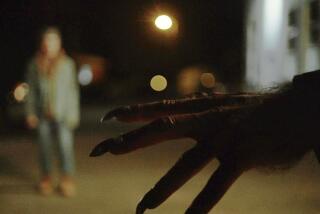Movie fiction mirrors fact for L.A.’s real-life ‘nightcrawlers’

Marc Raishbrook was showing off video of a bear when the news came. A public-transit accident. Exposition Line. Woman possibly trapped on the tracks.
“Time to work,” Raishbrook said from the back seat of his Dodge Charger.
“Probably near Vermont,” his brother, Austin Raishbrook, said from the from passenger seat, as the car idled in a downtown parking lot after midnight on a recent Saturday.
“She could be out and in the ambulance any minute,” Marc said, as he tossed down the laptop, on which he had been playing video he recently shot of a bear rummaging through trash of a suburban restaurant, and slid behind the wheel.
“That wouldn’t be good,” Austin replied, as the car jetted onto the 10 Freeway.
To many of the people who’ve seen writer-director Dan Gilroy’s “Nightcrawler” since it hit theaters Halloween weekend, the film is a dark fantasy, a fever dream of an L.A. that exists more on screen than in real life. Jake Gyllenhaal’s loner Lou Bloom prowls the streets during the wee hours looking for high-value accident footage--a larger-than-life, possibly sociopathic character who seeks out the most gruesome or sexy story he can find so he can sell it to local news stations.
But it turns out the film is a largely accurate portrayal of how half a dozen like-minded entities operate in Los Angeles. (The British-born Raishbrooks’ RMG Media, which also includes Austin’s twin brother Howard, is among the top outfits.) These are men who know your mother’s advice that nothing good happens after 2 a.m. and like it that way, choosing to work the freeways and police scanners long after the last unionized news cameraman and (nearly every other sane Angeleno) has hit the pillow.
“I think a lot of people watch the movie and think it’s a heightened, very unrealistic version of the job,” said Gyllenhaal, who went out on a ride-along with the Raishbrooks. “But everything that happened in the film either happens all the time or has happened some time.”
Like Bloom, the Raishbrooks are daredevils with a camera or vultures with a mercenary streak, depending on how you view them (though, in an age of citizen journalism and declining TV news budgets, their business is also beset by numerous challenges).
As in the film, there is also a sense of ruthless competition. At one site on Saturday, the Raishbrooks arrive a minute too late, finding rival Scott Lane, a brassy man in a ballcap bearing the word “Press” in all capital letters, already there. “Hey, nightcrawler,” he smirked to Austin. (What the Raishbrooks do is called “stringing”; the term “nightcrawler” was invented for the film.)
And like their cinematic counterpart, the Raishbrooks also see the late-night Southland and its vast, often-tragic geography as a dramatic canvas, undertaking Herculean efforts to ensure they have a front-row seat.
“The idea that I’ll go to sleep and miss something is enough not to make me ever go to sleep,” Austin Raishbrook said.
Gilroy wrote the script several years ago and sent the piece to Howard Raishbrook, who, along with his brothers, came on as technical advisors to the film.
As the brothers (they usually ride separately) cruise from Inglewood to Palmdale, from Westwood to east of downtown, their goal is to position themselves close to where a police or fire department event might happen. The half-dozen scanners in their cars are cranked up for the latest report, their smartphones in hand as they search for Twitter tip-offs.
When an event does happen, they must make a split-second decision before taking off in that direction, a calculus based on a complex set of factors such as genre of incident, distance and a larger context.
That last one is trickiest. Drunk-driving accidents, mudslides, police chases — all of them have a value. The key is figuring out which payoff is likely to be worth the time. After all, every accident you chase is another accident you’re giving up.
Car crashes are valuable, providing it was a grisly one and the scene has yet to be cleared.
Fires and natural disasters are good, but the flames or mudslides generally still need to be in full effect when the men arrive.
A police chase is the Platonic ideal of stringing, but only if you can capture the fugitive head-on, like returning home; long-distance video on the freeway is worthless.
And gun violence is variable. “The same shooting is worth a lot less in South Central as it is in Brentwood,” Austin Raishbrook said. “We don’t usually go to Compton.”
The Raishbrooks previously were featured in a reality show on TruTV titled “Stringers: LA.”
Though the series in 2008 was short-lived, the brothers said it reinforced their belief in the profitability of non-news venues. Supplying entertainment footage to the likes of police-chase highlight videos, they say, has lately become a bigger source of revenue. The show also prepared them for artistic license on “Nightcrawlers,” such as exclusive news deals (“We’d never make one,” Austin said) and the inclusion of news station scenes (“I’ve never visited one”).
It was a trade-off they were willing to make in part because their participation netted them a bucketful of new high-tech scanners, a currency better than gold in the stringing world.
Stringers talk of accidents the way most people talk of rare baseball cards, a jaded way of speaking that some say puts them on ethically dubious terrain. But they and their defenders say that such criticism misses the point.
“There are people who see stringers as ambulance chasers trying to capitalize on the gore, but that’s not how they see themselves and it’s not how I see them,” Gilroy said. After all, “if people didn’t want to see this, the brothers would be out of business.” He said he made the film hoping people would walk out of the theater thinking more of what it said about our media appetites than it did of the people feeding them.
The Raishbrooks started stringing when they arrived in Los Angeles from their small-town British countryside home more than a decade ago. At first it was just fun, a hobby, if one harsh on their sleeping schedule, motivated by a childhood of by watching “Cops” and other neo-vérité reality shows. But when Lane told them they could make money, they began diving into it in earnest.
The Raishbrooks found much to like in “Nightcrawlers.” “I love the way Jake captured the intensity of what we feel every night,” said Marc Raishbrook. (In a neat irony, Gilroy cast the Raishbrooks as extras in the film who are taunting Bloom when he gets to a scene too late.)
But there are differences between the brothers’ jobs and the movie.
Though a stringer could bag several thousand dollars for the right footage, in real life there is a major market crisis. Strapped local news operations are increasingly unwilling to open up their wallets; indeed, KTLA has just told them it won’t be buying footage.
Encryption on scanners has also become an issue. Reporters and stringers cried foul when the Pasadena Police Department encrypted its scanner communications. Officials relented — slightly — and allowed dispatch to remain unencrypted but kept the unit responses encoded. It was an empty victory for stringers because they still didn’t have the details necessary to determine whether an incident was worth the trip.
And digital media has dramatically changed their business, generally for the worse.
“People with their iPhones are giving away the footage for nothing but a Twitter credit,” Howard Raishbrook said.
To compensate, the Raishbrooks and others are looking to shift their revenue plan. “We really need to move to an advertising model,” Austin Raishbrook said. “That’s what we’re trying to figure out — advertising on YouTube.
“But there you need a million hits just to make a dollar,” lamented Marc Raishbrook.
There’s little time for the Raishbrooks to reflect on their business as the brothers gun their Chargers through Los Angeles. At the transit accident, Marc deposited Austin two blocks from the scene, barely slowing as his brother jumped out and took off down the street with his camera in tow.
Austin got up on the platform to shoot the scene, then realized the woman had just been rescued, driving the value of any footage down.
“Well, those 30 seconds cost us a bit of money,” Austin said, dejectedly, as Marc joined him at his side a moment later.
“Did you get her in the ambulance at least?” Marc said.
“Yeah,” Austin said glumly.
More to Read
Only good movies
Get the Indie Focus newsletter, Mark Olsen's weekly guide to the world of cinema.
You may occasionally receive promotional content from the Los Angeles Times.







